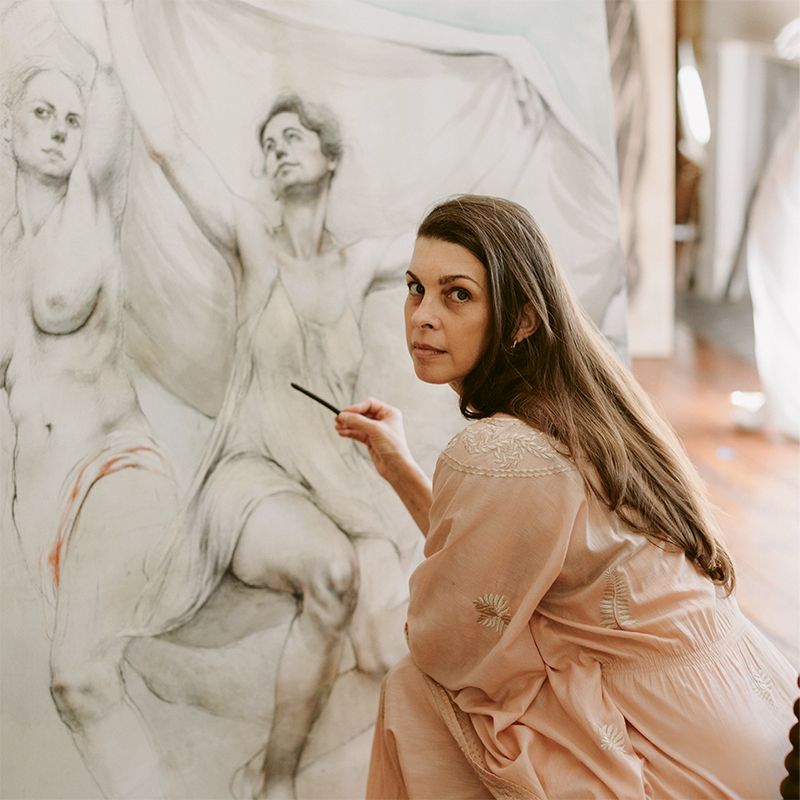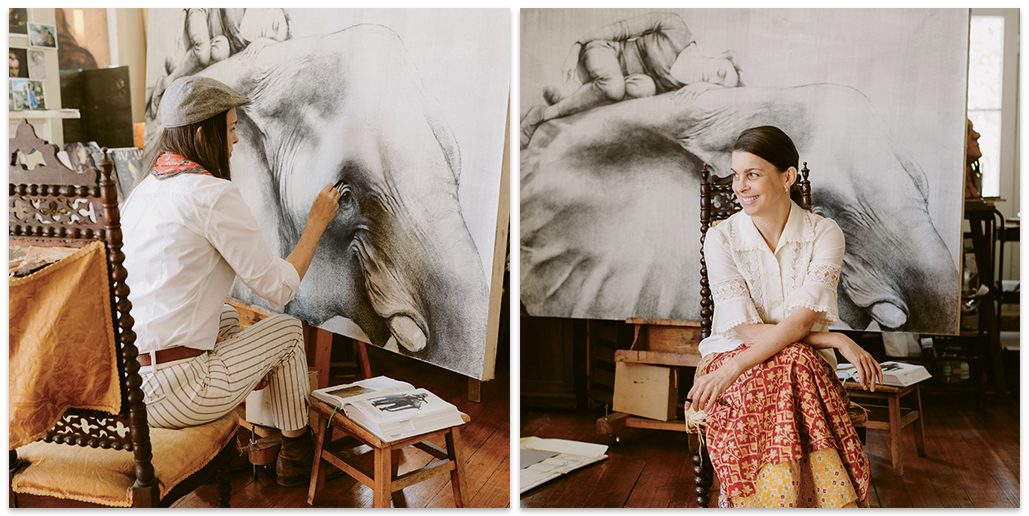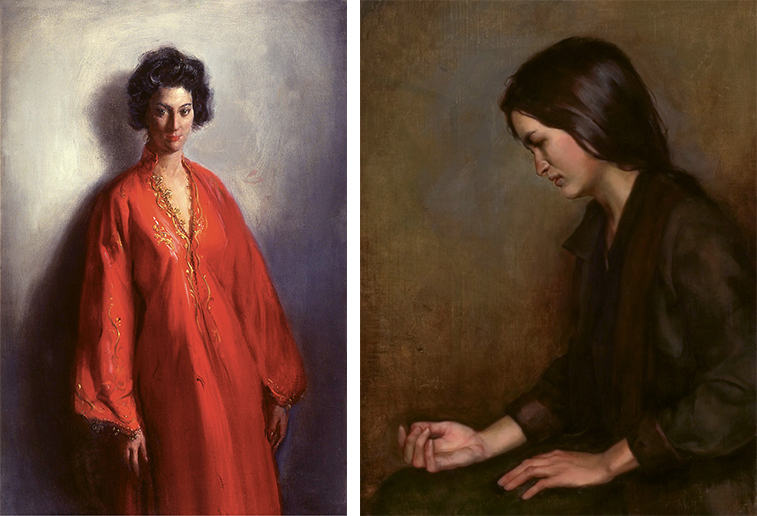Preparing for a major museum exhibition, classical realist painter Jill Hooper finds herself in good company—and she’s loving it

I hadn’t double-checked the address, so trusting was I of my memory, but alas, I’m on the wrong block. When I look in my rearview mirror, there’s Jill, waving me back a few houses. Better yet, she’s out in the street, on a blazing hot morning, blocking traffic so I can snag the one open parking space.
My navigational challenges aside, the Jill Hooper aura is just as I remember: her warm welcome (“Come in, have a seat. Something to drink?”) and her home’s antiqued hues (a cozy parlor painted deep ochre, its walls filled with a collage of gold and black frames). One corner displays a veritable orchard of her work—a series of delicious peach still lifes, each luscious and tempting, their fragrance almost emanating from the canvases. A thick volume on Leonardo da Vinci anchors a desk; more paintings and sketches are propped on a vintage settee, its crushed velvet upholstery frayed at the seams, well-loved in a Velveteen Rabbit way.
In the adjacent dining room, a corner of the table looks like a café with a mannequin poised as a dinner partner, a mirror looking over his shoulder so Hooper can sit across and paint her own reflection. “This is where I stage my self portraits,” says Hooper, explaining that, after years of painting somber versions, she no longer wants to be the lone subject in the composition. It’s time for company, for connection—hence Mr. Mannequin.
A portrait gallery along the center stairwell leads to Hooper’s second-floor studio. Works by her, as well as artists she knows and admires, line the wall, a congregation of faces, eyes, mouths—the endless nuances of expression reflected in portraiture. These nameless faces watch me as I walk up the creaky old stairs, and as I do, I distinctly recall a nude model, Eric, who was poised just-so in her studio more than a decade ago (funny how some memories stick better than others). On that visit, I observed her teaching a figure-drawing workshop. A classicist through and through, Hooper always works “from life,” as “it’s a much richer experience,” she says. “By being present, an essence naturally reveals itself in the drawing or painting.”

Scaling Up: “My teacher Charles Cecil would say, ‘life-size is more lifelike,’ says Hooper. She’s testing that theory out on five new works for this fall’s Gibbes Museum of Art show.
But today, there are no students, no Eric. Even so, Hooper’s studio feels alive, drenched with natural light from large north-facing windows and filled with a jumble of easels, stools, and old chairs; cabinets stuffed with art supplies; and busts and vases scattered hither and yon, ready to serve as props or inspiration. At the front stands a statue-like figure heavily draped in white fabric, dramatic folds falling in a carefully orchestrated corrugation. It resembles a classical sculpture, something scooped right out of Brookgreen Gardens, and beside it Hooper’s life-size drawing of it, still in process.
This recent shift toward large-scale, often life-sized drawing represents rewarding new territory for Hooper, who’s best known for her richly saturated still lifes and moody self-portraits, including a beautifully haunting one that won a spot in the prestigious British Petroleum Portrait Exhibition at London’s National Portrait Gallery in 2007. “I’m intrigued by the calligraphy of charcoal, the way a line can push and pull, help something recede or give action, denote places of movement,” she explains. “I’m drawn to this sense of fluidity,” she adds, pointing to the tumble of folds, the draping’s graceful relinquishment to gravity.
This drawing is part of a body of work to be featured at the Gibbes Museum of Art this fall in an exhibition titled “Influence and Inspiration: the Art of Jill Hooper, Ben Long, and Frank Mason.” The show not only underscores the mastery that Hooper—already the youngest living artist to be included in the Gibbes’s permanent collection—has achieved at this point in her 25-year career, it examines the relationships and cross-fertilization of artists over generations: Frank Mason, a realist painter and teacher at the Arts Students League for more than half a century, was a major influence and inspiration for North Carolina-based fresco master and classical realist Ben Long, who in turn has been a prominent teacher and mentor for Hooper.
“This [exhibition] is important to me, after all, it is every artist’s dream to have a museum show. This one is particularly special—to be exhibiting with my friend and teacher—yet intimidating, as well, since Ben is a living master,” says Hooper. So she’s been doubling down, working long hours to put finishing touches on five new large-scale drawings, as well as an oil painting and numerous studies for the exhibit, while also trekking to Asheville, where’s she’s been assisting on a fresco project with colleagues she met through Long. “I feel like I’m at the pinnacle of my education, though I’d like to think my pinnacle is yet to come. Nonetheless, this is not the time to slow down, but to push harder.”
A DEEP BELIEVER
Originally from upstate New York and raised largely in North Carolina (her parents moved to Southern Pines when she was 11), Hooper has been drawing nearly all her life. “There was never any question that I’d be an artist,” she says. At age 15, she began apprenticing with D. Jeffrey Mims, a classical painter and muralist who recognized and nurtured her nascent talent. As a studio art major at the College of Charleston, Hooper had the opportunity to study in France and Italy, where she gravitated to the European Beaux Arts oeuvre and continued her enchantment with, and mastery of, the human figure.
In addition to Mims, her teachers and mentors include Charles Cecil, with whom she has studied intensively in Florence, Italy, and Ben Long, with whom she has worked and studied alongside in Italy, North Carolina, and Charleston. “I first met Ben when I was 15,” she says. “My teacher [Mims] was his student several years prior while working on the Glendale Springs fresco. He took me to see Ben’s fresco while it was still in progress at Saint Peter’s Church in Charlotte. It was something to behold.” More than a decade later, she apprenticed with Long on a fresco at The Crossnore School in Avery County, North Carolina.
“Jill’s always been a deep believer in fine drawing, and I’m so admiring of that. She’s dedicated in all the right ways,” Long says. “Jill and I both always work from the examination of life, not photographs. You can tell, with the trained eye, when a fine drawing or fine painting is done from life. It’s what’s between you and the model and the air that surrounds you, that whole vibration of life is included in your drawing and your painting—at least, it should be,” adds Long.

Hooper has had a lifelong fascination with elephants and has made several trips to Riverbanks Zoo to do studies of its one-tusked wonder that will debut in the Gibbes show.
Her work is “now more about challenging herself than proving herself,” says Gibbes director Angela Mack.
As the consummate and continual student, Hooper’s work ethic is uncompromising. She endlessly refines her technique, perfecting the play of light, contours, colors, and expressions. She sizes her paper with homemade rabbit-hide glue; works only by natural light and with live models when painting; and continues all day with few breaks. “I love painting still lifes and figures. I put all my heart in it, but it’s grueling,” she says. “For years, I worked from sunrise to sunset, every day. I just knew I had to put in the time,” she says. “People will ask how I’ve learned to convey humanity so well—it’s called showing up every day.”
In moving from oils to life-size drawings, Hooper says she’s enjoying a new sense of freedom. For one, because the medium is monochromatic, she’s not constrained to using natural light. And for her subject matter, she’s finding herself drawn to images of “levity and lightness.” Her first study for the Gibbes show was of two angelic female figures, almost dancing in the air.
“I was inspired by the fluidity and freedom of this amazing American dancer in turn-of-the-century France,” says Hooper. The piece, Friends of Loie Fuller (the dancer’s name), which will be included in the exhibition, evokes movement, joy, and relationship. But the work of it is rigorous and unforgiving. In painting oils, a mistake can be brushed over, but in drawing, “every mark matters,” Hooper says, because charcoal can’t be easily erased, especially on the highly specialized paper that Hooper spends months making and prepping.
“It takes solid concentration for six-hour stretches at a time. I have to be in the correct physical and mental state to get that perfect mark down; each one is on the verge of destruction or glory,” she says. “I’m at this point of taking all my education and then adding in a little bit of abandonment. It’s finding that sweet spot between my academic brain and flow, between control and abandonment.”
“Jill is so systematic, slowly and calmly building her ideas from a measured start to completion,” says her friend and colleague Ann Witheridge, founder of London Fine Arts Studios where Hooper has spent several months each fall and winter—“as long as my visa allows”—for the last seven years. Charleston is her home and workspace, but those months in London, with excursions to Florence to paint with her longtime friend, Kamille Corry, are her creative lifeblood, her refueling. “My friends there speak my creative language. I love being around other artists who have trained similarly to me. I love learning from them,” she says. “When I make my ridiculous art jokes, they get it.”
FINDING LEVITY & LIGHT
Hooper is doing her best these days to integrate her serious and light-hearted sides, to bring more “levity and light” to her work, she says. “It takes a huge amount of energy to do this day after day, living and working alone. I find I do relate more to paintings of loneliness and despair, but let’s face it—it’d be a waste not to acknowledge humor. Sometimes it seems the more despair, the funnier things become—great humor and great despair are pals, thank goodness.”
From a technical side, however, this shift in subject matter isn’t all fun and games. “Finding the levity takes more courage, energy, and creativity,” Hooper says, acknowledging that she’s got serious down pat. “Painting someone who looks depressed? A piece of cake,” she says. “But happiness is hard. Capturing a smile without making the subject look ridiculous is hard.”
On the personal front, Hooper is finding that sense of uplift by spending time with kindred artistic spirits, particularly on the fresco she’s been assisting with recently in Asheville. “It’s like summer camp, but for artists,” Hooper says of the months-long project at the Haywood Street Church. “A fresco takes a team, and I’m here to help. I love these people,” she says of the five-person squad, led by her friend Christopher Holt. She met the Asheville-based artist when they worked with Ben Long on a different fresco years ago. Titled The Beatitudes, Holt’s 28½- by 11-foot composition depicts members of Haywood’s congregation, many of whom are homeless and seek food, clothing, and solace at the church’s Downtown Welcome Table. Once complete, this monumental work will, Holt hopes, celebrate the humanity of those often marginalized by society.
“I’m so moved by this project,” says Hooper, who’s in charge of tracing the sketched composition onto the fresco surface. “These are people who probably never dreamed of owning original art, and their images will be part of this fresco that will last well beyond our lifetimes.” Plus, it’s been a blast—“as close as artists get to being in a band,” she says. And fun is good; collaboration and camaraderie are good—whether in Asheville or in London where Hooper will return to teach and study later this month.
Indeed, this interplay of creative energy and artistic relationship is part of what the upcoming Gibbes exhibition explores. Museum director Angela Mack and Hooper conceived of the show when they were in New York last year for a special viewing of the Metropolitan Museum of Art’s Michelangelo drawings. During the visit, Hooper brought Mack to the late Frank Mason’s studio in the East Village. “I was looking at his drawings and realizing the relationships between Frank’s work, and Ben’s, and then, of course, Jill’s,” says Mack. She hopes that by viewing their studies, drawings, and paintings together, exhibit-goers will walk away with a deeper understanding of the artists’ processes and sense of community.
“It adds to the conversation of this relationship among artists, how they learn from each other, how they share ideas, and how their work changes based on talent they have, the skills they’ve acquired. It just made perfect sense,” says Mack, who has followed Hooper’s career over the decades and watched her evolve as an artist. Her subject matter has become more symbolic and more varied, Mack notes. “Jill is playing with textures and points of view that are more provocative, and that comes with maturity,” Mack notes. “Her work now is more about challenging herself than proving herself. She’s taking more risks, not letting herself be hemmed in, and I love that.”
The exhibition, curated by Pam Wall, will juxtapose these masters of classical realism and bring together good friends and colleagues. “Ben and I go way back. I know he loves me, and I know he loves giving me a really hard time,” says Hooper. On this summer’s fresco project, Hooper is working alongside Long’s son, Anselme, an apprentice on the Haywood Street fresco, so the multigenerational mentor-mentee connections continue. And possibly payback does, too.
“Evidently my nickname behind my back is ‘The Hammer’,” says Hooper. “My job is to keep things going and take the team across the finish line.”

Hooper spent extended chunks of her summer in Asheville, North Carolina, where she and fellow artists prepped and began a fresco titled The Beatitudes, that will command a 28½- by 11-foot central wall of the sanctuary at Haywood Street Congregation.
The Haywood Street Fresco
Hooper spent extended chunks of her summer in Asheville, North Carolina, where she and fellow artists—including (pictured below, left to right) Anselme Long, Caleb Clark, John Dempsey, and fresco creator and principal artist Christopher Holt—prepped and began a fresco titled The Beatitudes, that will command a 28½- by 11-foot central wall of the sanctuary at Haywood Street Congregation. “It’s been a blast,” says Hooper, of working alongside Holt and the fresco squad. The piece depicts members of Haywood Street Congregation, most of them among Asheville’s homeless community, to “affirm sacred worth, restore human dignity, sabotage the shame of poverty, and announce, in plaster and pigment, that you matter,” according to the project’s mission statement.

Susan in Costume by Frank Mason (oil on canvas, 59 x 37 inches, 1959); (right) Hirona by Jill Hooper (oil on linen on panel, 32 x 24 inches, 2009)
A Legacy of Artistic Mentorship
A special Gibbes Museum of Art exhibition examines three generations of classical realists
“Influence and Inspiration: The Art of Jill Hooper, Ben Long, and Frank Mason”
September 6, 2019 - January 5, 2020
This Gibbes Museum of Art exhibition celebrates three artists who share a devotion to classical training and whose relationships and influences cross three generations. Featuring studies and paintings by each artist, this collection reflects the rigorous training and preparation behind each finished work and offers a glimpse into the artists’ creative processes.
Special Events:
September 11: Landscape Painting with Jill Hooper and Ann Witheridge
Classically trained artist Jill Hooper and Ann Witheridge, founder of London Fine Art Studios, will lead a plein-air landscape painting demonstration. Wednesday, 6 p.m. $60, $50 member
November 14: Guided tour of “Influence and Inspiration” with artist Jill Hooper; Thursday, 2:30 p.m. Free with museum admission.
Gibbes Museum of Art, 135 Meeting St. (843)722-2706, gibbesmuseum.org
Images courtesy of (8) Jill Hooper, (2) Haywood Street Fresco; (1) Ben Long, & (1) The Estate of Frank Mason